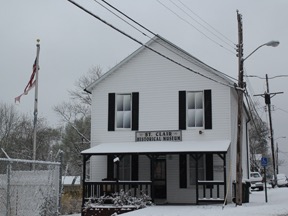Making Tracks
November 2019

As soon as I entered, I knew Lewis Café was a keeper. Hardwood floors. Chrome-plated chairs with vinyl seats pushed up to tables that had local business ads laminated inside. Real pictures on the walls.
And I was right about the home cooking. The onion rings are homemade. The coconut cream pie is homemade. The chili is homemade. The beef is home grown. I was at home on the road, a rare feeling. I counted the booths. Seven. Across from booth row, seven squatty stools stood at the low counter. The place radiated good vibes. Daniel, the server, was the owner’s son. He was enthusiastic, with no hint of preacher’s kid attitude. More important, when he said that today’s blue plate special was outstanding, I believed him.
Outside the storefront window, the snow came down in flakes the size of Frisbees. It made the restaurant even cozier. An elderly couple came in from the blizzard and took a seat. The woman was distressed by the weather and further distressed by her dead cell phone. She couldn’t call her destination to report their travels had been interrupted. I loaned her my cell phone.
Daniel arrived with my meal, and I ate as the snow piled up outside. When I finished, I asked Daniel for directions to the St. Clair Historical Museum.
“Easy,” he said. “Go down Main Street one block and make a right. Can’t miss it.”
Sure enough, I saw the big painted museum sign above the door of an old house on the corner. Through the falling snow I could read the museum’s business hours: “Open 1–4 p.m. Saturdays and Sundays.” I was in luck. It was 2 p.m. Saturday. So I pulled to the shoulder and stepped out into four inches of fresh snow. As I walked to the museum entrance, I noticed that my tracks were the first upon the front porch. I tried the door. It was unlocked. So I entered.
“Hello?”
No answer. The lights were turned off, and it was apparent that no curator was present. That’s understandable. Who would expect a visitor to a small-town museum on a snowy afternoon like this?
I fumbled around in the darkened room for a light switch as a staccato beep began to register in my ears, soft at first but getting louder with each successive beep. The burglar alarm! I hesitated, and considered looking around the museum for a bit while waiting for the police to show up.
Then I envisioned handcuffs and delays and fingerprints and lengthy explanations and 18 coats of paint on the iron bars across the front of the cold confines of a rural jail cell I’d be sharing with some sobering-up wife beater. So I calmly exited the house, shut the door behind me and waited for the cops. Nobody showed up, even though I could see the police station from the porch. I slowly walked toward Erifnus, allowing plenty of time for the authorities to respond to the alarm.
I scraped an inch of new snow off Erifnus’ windshield, climbed in the cockpit and backed onto a side street. I took my time turning around, leisurely driving back up to the main street, and looked for a policeman. But nobody. They must’ve been busy attending to a dozen fender benders on the slick streets. I drove around town taking pictures and circled back to the museum. The alarm was turned off. Nobody was around. We made tracks out of town.
Visit JohnDrakeRobinson.com to read more about John’s travels.
